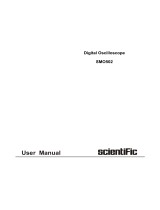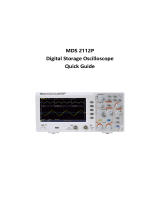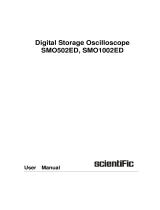
SIGLENT
SDS1000L User Manual VII
Content
Brief Introduction .................................................................................................II
Chapter 1 Accidence ..............................................................................................1
1.1 Accidence of Panel and Display Information...........................................................2
1.2 Function Checking ...................................................................................................5
1.3 Probe ..................................................................................................................7
1.3.1 Probe Safety.................................................................................................7
1.3.2 Probe Attenuation Setting ..........................................................................7
1.3.3 Probe Compensation ..................................................................................8
Chapter 2 Functions Instruction and Operation .....................................................9
2.1 Menu and Control Button.......................................................................................10
2.2 Connector ...............................................................................................................12
2.3 Auto Setup..............................................................................................................13
2.4 Default Setup..........................................................................................................14
2.5 Universal Knob ......................................................................................................15
2.6 Vertical System.......................................................................................................15
2.6.1 CH1, CH2 Channel....................................................................................16
2.6.2 Using Vertical “Position” Knob and “Volt/div” Knob ..............................21
2.6.3 Math Functions...........................................................................................21
2.6.4 Using Ref ....................................................................................................27
2.7 Horizontal System..................................................................................................29
2.7.1 Horizontal Control Knob............................................................................30
2.7.2 Window Zone .............................................................................................30
2.8 Trigger System .......................................................................................................32
2.8.1 Signal Source.............................................................................................33
2.8.2 Trigger Type................................................................................................34
2.8.3 Coupling......................................................................................................47
2.8.4 Position........................................................................................................47
2.8.5 Slope & Level .............................................................................................48
2.8.6 Trigger Holdoff........................................................................................49
2.9 Acquiring Signals System ......................................................................................50
2.10 Display System.....................................................................................................56
2.10.1 X-Y Format ...............................................................................................59
2.11 Measure System ...................................................................................................60
2.11.1 Scale Measurement ................................................................................60
2.11.2 Cursor Measurement ..............................................................................60
2.11.3 Auto Measurement ..................................................................................66
2.12 Storage System.....................................................................................................72
2.13 Utility System.......................................................................................................85
2.13.1 System Status..........................................................................................88
2.13.2 Language..................................................................................................88
2.13.3 Print ...........................................................................................................89
2.13.4 Self Calibration.........................................................................................92
























